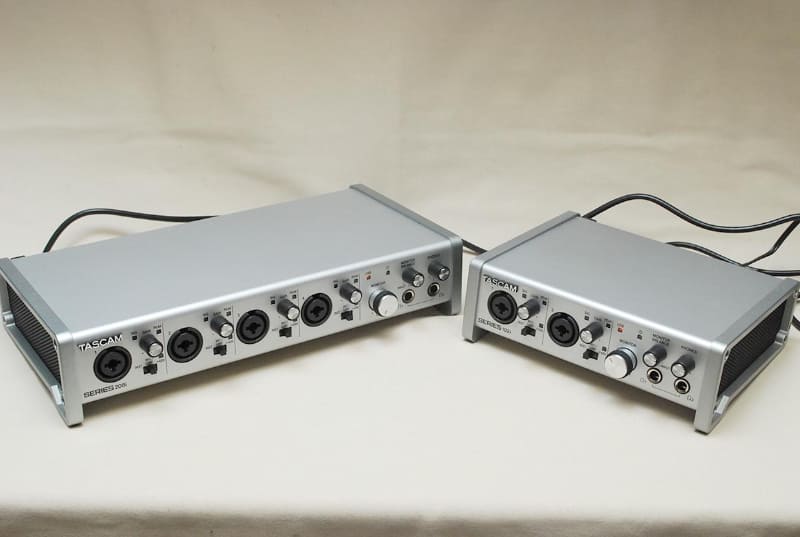
TEAC's professional brand, TASCAM, launched two new USB audio interfaces this July, each one being the SERIES 208i and SERIES 102i. The looks of these two new models are heavily similar to previous US-2x2 and US-4x4, but the different internal mechanism makes the SERIES models stand above the conventional models. Let's check the audio performance and latency values to see why.

SERIES 208i (left) and SERIES 102i (right)
The TASCAM SERIES 208i and SERIES 102i are labeled as high-grade audio interfaces. The 20-in/8-out 208i retails for $499.99, and the 10-in/2-out 102i for $399.99. Taking into account the US-2x2 (which looks almost the same as the 102i) originally retails for $199, we can see that's quite a price leap in the SERIES models.
According to TASCAM, the SERIES 208i and 102i equipped the high-grade Ultra-HDDA mic preamp and a whole new re-designed circuit system, enabling even lower noise compared to the US-2x2 and US-4x4. In addition, the digital circuit was renewed to extend support up to 192 kHz in comparison to the conventional 96 kHz. The newly added DSP function to both models also helps improve overall user performance with individual EQ, comp and reverb functions.
Even though the looks and sizes are mostly the same, one thing people might feel a bit strange about is the fact that US-2x2 is a 2-in/2-out unit, whereas the SERIES 102i is a 10-in/2-out unit. While having almost the same front layout as the US-2x2, SERIES 102i has an optical input installed on its rear side. Instead of traditional S/PDIF, this optical input employs S/MUX, the expandable version of ADAT, allowing the unit to have 8 more inputs. Combining the analog 2-in/2-out you get the total 10-in/2-out channels.
On the other hand, the SERIES 208i has 4 combo jack inputs on its front and 2 optical inputs on its rear panel. The output consists of 8 analog line outputs, so in total SERIES 208i supports 20-in/8-out channels. Furthermore, both models support MIDI in/out, and the 208i also equips word clock in/out terminals. Using this, it is possible to synchronize other external digital equipment.
However, let's not forget that other external equipment must also support S/MUX to be able to use the expansion mode in the SERIES models. For this, TASCAM also released a new mic preamp called SERIES 8p Dyna which can be linked with other SERIES models, and conveniently comes with a compressor function included. According to TASCAM, this mic preamp shares the SERIES name, but the mic preamp performance is above its other two siblings.
Also, while the US-2x2 was able to work via USB bus-power, maybe due to the additional optical inputs or the DSP function, the SERIES 102i needs power to be supplied with the included AC adapter.
The SERIES 208i and SERIES 102i are both USB class-compliant devices and can be used with Windows 10 and Mac computers without a driver. Using a Lightning USB camera adapter will also enable its use with iPhones or iPads.
However, to use Windows ASIO driver, there's the necessity to download and install the "Settings Panel for Windows" driver from TASCAM's website. In any case, there is also a "Settings Panel for macOS" for Mac, which does not include a driver, but is almost essential for using SERIES 208i and 102i.
Let's see SERIES 208i performance now that I have installed the Settings Panel in my Windows computer.
Both SERIES models come with Steinberg's Cubase LE included, and it seems this DAW already identifies the 208i as a 20-in/10-out audio interface. Generally, the 208i should be displayed as a 20-in/8-out interface, but then I realized that in fact, this is a virtual input/output port seen from the DAW side, which allows us to do quite complicated operations. That's when the Settings Panel takes in for such controls. In the ROUTING tab, for example, we can check and change some of the routing configurations.
On the right side of the screen, you can see the analog outputs LINE OUT 1-8 where you can freely assign channels. The port #10 we saw earlier in Cubase's screen corresponds to the Computer BUS on the Settings Panel upper-right screen, which also has 10 ports; and how to output them depends on the setting. Also, by using the Monitor Select setting, the balance of the signal output from the monitor can be adjusted.
Opening the "MIXER" tab will show all 20 channels including S/MUX ones onscreen. Each channel is independently divided with individual EQ and comp settings that can be flexibly adjusted to preference. These settings will be applied to the signals sent to the computer when recording.
The MIXER tab screen is displayed as a mixing console layout where faders and PAN knobs can be adjusted. The mixings are combined into the MASTER, which is routed to the MASTER output set in the previous ROUTING tab screen.
Also, reverb can be added to AUX1 thanks to the DSP, allowing monitoring with less power consumption from the computer's CPU. However, this is only applied for the MASTER output, and not to the recording signals.
The Settings Panel for SERIES 102i has the same ROUTING and MIXER tabs and functions with fewer channels displayed and with a more simplistic look.
I used the RMAA Pro to test SERIES 208i audio specs. The results of each sampling rate from 44.1 kHz - 192 kHz are shown below; the S/N ratio, frequency band and dynamic rage all lead to the fact that this model has a great performance overall. I can see that it is quite different from the US-2x2 that I once checked before.
Let's now check the latency values on the SERIES models. A unique point compared to other audio interfaces, is the fact you can set the minimum buffer size of 4 samples, which can be set through the Settings Panel INFORMATION tab. I have never seen such a small buffer size configuration anywhere else. Although the smaller the buffer size is, the more CPU power is used, I believe CPU nowadays have better specs and would perform normally even with small buffer sizes.
So I tested the latency on each sampling rate, from 44.1 kHz - 192 kHz with the buffer size in 4 samples. I also did a test for 44.1 kHz in 128 samples for the comparison.
Looking through the results above, although in 4 samples, the latency is not low enough to outshine all other competitors. Still, 4.81 msec in 192 kHz is a pretty good record.
Although the interface settings depend on knowing what kind of CPU is installed on the computer in use and how much load is applied to it, one thing for sure is that the new TASCAM SERIES models are both great high-spec and high-performance audio interfaces for their price range.

Ken Fujimoto
After working for Japan's leading human resources company, Recruit, for 15 years, Fujimoto established Fractal Design Inc. in 2004. He has been writing articles related to MIDI, audio, and recording since his days at Recruit, and shares great system knowledge thanks to his previous involvement in sequence software and MIDI interface development, as well as sound-source making for computers. Written works include "Complete DTM Guidebook" (Rittor Music), "Dekiru Hatsune Miku & Kagamine Rin / Len" (Impress Japan), "MASTER OF SONAR" (BNN Shinsha), among others. In addition to running the blog-style news site, DTMStation, Fujimoto works as a guide for DTM and digital recording at All About. Twitter @kenfujimoto